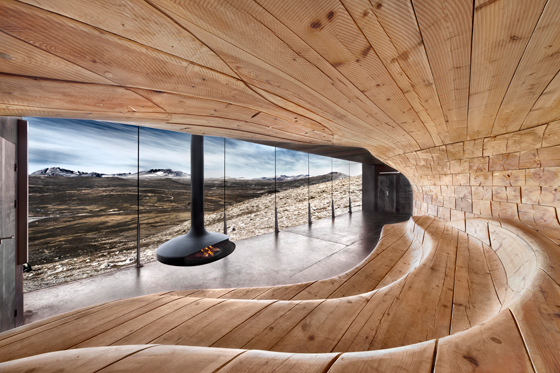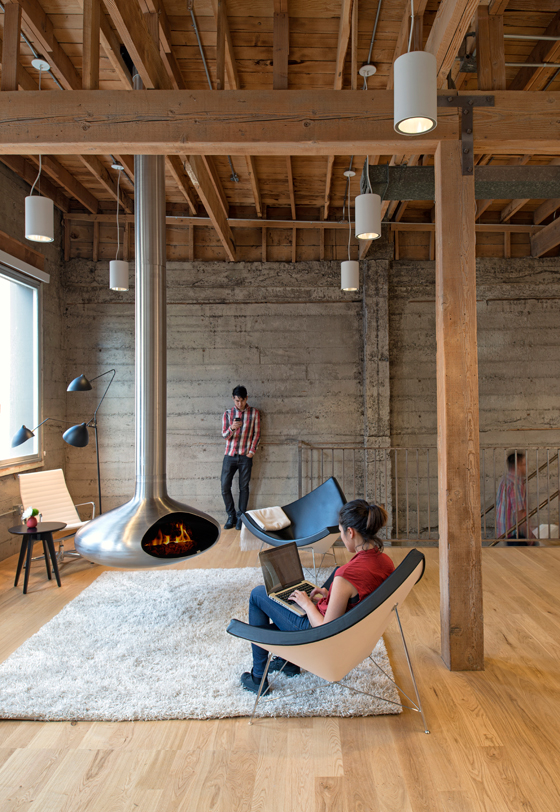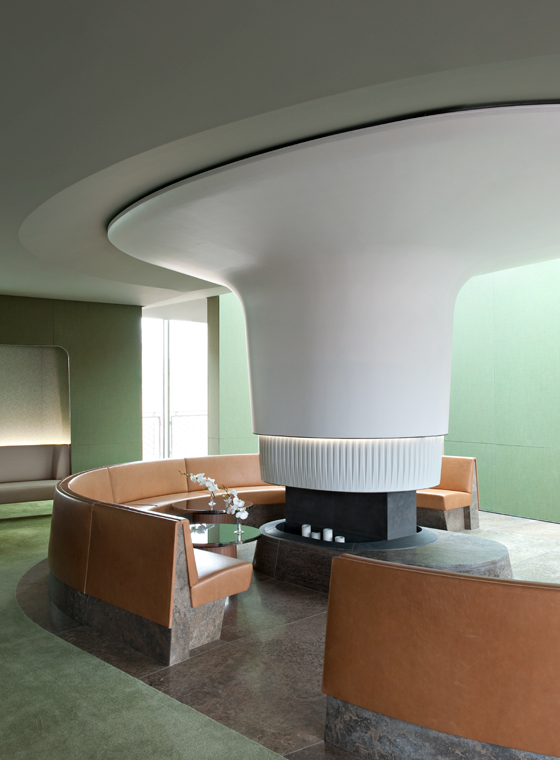Hearth and Home
Texto por Dominic Lutyens
London, Reino Unido
18.11.14
Fireplaces were once essential: from prehistoric times to the 19th-century, a home’s hearth provided light, heat and a means with which to cook. Today, you might think they were superfluous, obsolete in this age of centrally heated buildings. Yet our desire for fireplaces has never been entirely extinguished. Ironically, if they were once primarily functional, they’re now widely considered an unnecessary yet romantic luxury.
Haugen Zohar’s tent-like structure enclosing a fireplace. Its porous walls – made of recycled wood pieces arranged in ever-diminishing, concentric circles as they rise up the roof — glow at night; photo: Jason Havneraas

Haugen Zohar’s tent-like structure enclosing a fireplace. Its porous walls – made of recycled wood pieces arranged in ever-diminishing, concentric circles as they rise up the roof — glow at night; photo: Jason Havneraas
×As a focal point in homes, hotels and even ultramodern offices, they appeal on several levels. Arguably, they’re an atavistic throwback to the original fireplaces: fire pits dug into the centre of caves or huts. By the Middle Ages, these had migrated to a room’s stone walls. Just as people back then huddled around fireplaces to tell stories or have always hung out together around campfires, many architects today view fireplaces as social hubs.
No doubt fuelling their interest in them is our perennial attraction to the spectacular, overblown fireplaces of mid-century interiors, like those seen in the lairs of Bond movie villains. Remember the monumental steel fireplace in Auric Goldfinger’s wood-panelled Rumpus Room, reminiscent of a John Lautner-designed interior? For many architects now, the allure of fireplaces lies in their theatrical, sculptural qualities, in their ability to provide a dramatic focal point.
The fireplace’s age-old associations with nature are highlighted by this ceiling-hung design in Snøhetta’s glass-fronted Norwegian Wild Reindeer Centre Pavilion, where visitors enjoy panoramic views of roaming reindeer and rare plants
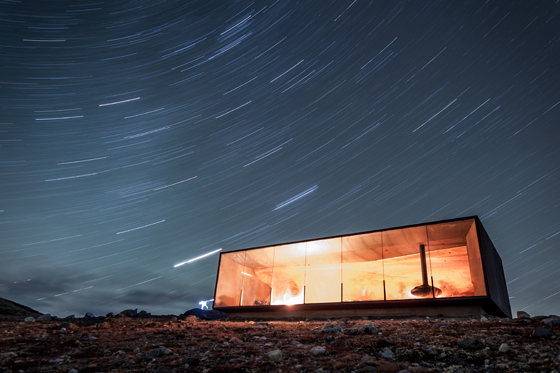
The fireplace’s age-old associations with nature are highlighted by this ceiling-hung design in Snøhetta’s glass-fronted Norwegian Wild Reindeer Centre Pavilion, where visitors enjoy panoramic views of roaming reindeer and rare plants
×At the 2014 Venice Biennale, Rem Koolhaas launched a set of booklets called Elements, which explore 15 archetypal architectural features, including the fireplace – proof that contemporary architects still consider it relevant. The one on fireplaces delves into the rich mythology that surrounds fire. Prometheus famously incurred the ire of Zeus by stealing fire from the gods and giving it to humans, along with (in Aeschylus’s version of the legend) writing, mathematics, agriculture, medicine and science. Fire, the booklet points out, can therefore be seen to symbolise enlightenment, civilisation and technological progress.
The booklet also provides a concise history of how the fireplace evolved, noting that, over time, new technologies threatened to usurp it: suddenly, cooking could be done on stoves and lighting provided by electric lights; later, storytelling was offered by radio, TV and even laptops, which, the booklet argues, have become the modern-day incarnation of the fireplace. It also observes that whereas most new-build homes in the US in the 1980s had no fireplaces, since the 1990s, they’ve been making a comeback as a luxury item, dampened only slightly by anxieties over emissions of greenhouse gases.
Top and above: The interior of the pavilion at night. The links between the building’s architecture and nature are emphasised not only by its fireplace but also by the organic, cave-like structure of its wood seating
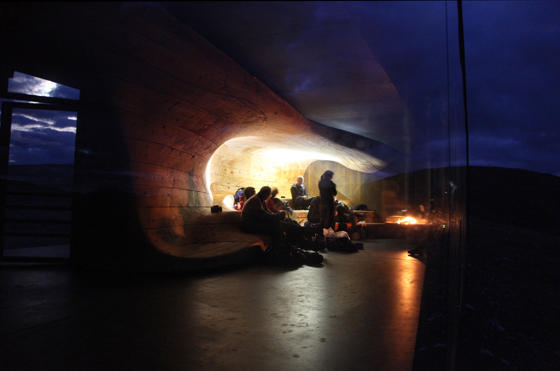
Top and above: The interior of the pavilion at night. The links between the building’s architecture and nature are emphasised not only by its fireplace but also by the organic, cave-like structure of its wood seating
×You’d have thought modernist architects might have dismissed the fireplace as mere frippery. But in Philip Johnson’s radically open-plan Glass House of 1949, the one permanent fixture is its surprisingly organic, circular, brick fireplace. Frank Lloyd Wright, who influenced modernist architects, made a fireplace a feature of his 1935 house Fallingwater, emphasising its importance by making the chimney the highest point of the house.
Suspended in the fireplace is a gigantic orb – designed to heat up mulled wine – which can be swung over the flames, proof that Wright saw the fireplace as the central gathering place for homeowners and their families. Fallingwater was an experiment in uniting architecture and nature. Not only does it jut out over a waterfall, but its hearth, which incorporates boulders found on the site, highlights another theme of fireplaces old and new: their association with nature and the elements.
A more urban spin on the fireplace can be found in this breakout space at Giant Pixel’s office. The fireplace has a 60s-retro vibe that complements the office’s mid-century furniture and industrial-chic interior; photo: Jasper Sanidad
A more urban spin on the fireplace can be found in this breakout space at Giant Pixel’s office. The fireplace has a 60s-retro vibe that complements the office’s mid-century furniture and industrial-chic interior; photo: Jasper Sanidad
×One example of this today is a fireplace enclosed within a primitivist, chimney-like structure designed for a kindergarten in Trondheim, Norway. Inspired by the country’s tradition of turf huts and log cabins, it’s made of recycled wood, stands on a concrete base and has an opening at the top. ‘Together with standard playground facilities, we wished to combine a space for fire, storytelling and playing,’ say its architects, Marit Justine Haugen and Dan Zohar of Oslo-based practice Haugen Zohar.
At Snøhetta’s glass-fronted Norwegian Wild Reindeer Centre Pavilion, which is open to the public, Focus’s suspended (and thus space-saving) Gyrofocus fireplace looks similarly primitive. Perched on serpentine wooden benches and warmed by the fireplace – which produces up to 6 kW of heat – visitors can observe the reindeer herds roaming the surrounding, almost lunar landscape of the nearby Dovrefjell National Park. The organic shape of the fireplace underlines the pavilion’s connection with its natural location.
Top and above: The curvilinear silhouette and natural materials of this fireplace — made of porcelain, plaster, basalt and limestone — play a key role in Jouin Manku’s interior for the lounge of Munich’s Bayerischer Hof hotel

Top and above: The curvilinear silhouette and natural materials of this fireplace — made of porcelain, plaster, basalt and limestone — play a key role in Jouin Manku’s interior for the lounge of Munich’s Bayerischer Hof hotel
×Another ceiling-mounted fireplace – in the San Francisco office of software developer Giant Pixel, designed by Studio O+A – has a completely different vibe. In slick, shiny metal and suspended above a shag pile rug in a cosy breakout space, the fireplace has a 1960s retro look that goes with the office’s mid-century furniture designed by the Eameses and George Nelson. ‘A core belief at O+A is that lounge areas in workplaces should have all the comforts of a home, and the fireplace is an example of that,’ says Al McKee, the studio’s marketing coordinator.
Not all contemporary fireplaces are designed to be dramatic and arresting. This fireplace by sandellsandberg for a house in a Swedish village is understated and highly functional with its two openings that heat up opposite ends of the living area
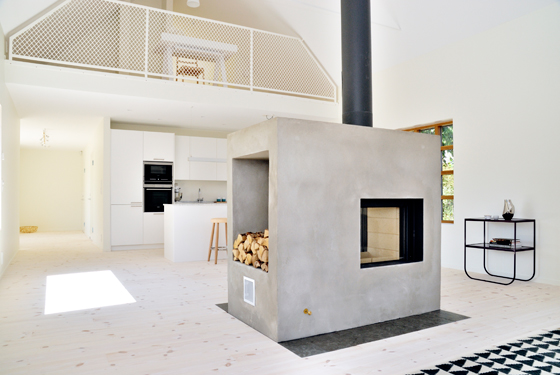
Not all contemporary fireplaces are designed to be dramatic and arresting. This fireplace by sandellsandberg for a house in a Swedish village is understated and highly functional with its two openings that heat up opposite ends of the living area
×Also providing the focal point for a social space is the fireplace at Lightroom Studio’s Dominey Pavilion, a wooden extension built around a tree for a house in Atlanta, Georgia. The fire is part of an outdoor living room open on three sides, which is even furnished with sofas. This fireplace, too, plays on the hearth’s traditional associations with nature: the architects were inspired by a tradition of freestanding fireplaces found in the Georgia countryside and by Wright’s love of rustic hearths. And the architects’ clients are fans of the Case Study Houses of the 1940s, which sought to fuse indoor and outdoor living.
Another unusual fireplace is Jouin Manku’s enormous, sculptural design encircled by curved benches in the sixth-floor lounge of the Bayerischer Hof hotel in Munich. The architects’ aim was to ‘recreate a natural landscape’ indoors inspired by views through a picture window of Bavaria’s mountains. Enhancing the fireplace’s extravagantly organic aesthetic is its white plaster surface, porcelain tiles and basalt and limestone base.
This arresting fireplace in a house in Bridgehampton, New York, is designed to be functional and sculptural: it comprises a load-bearing moment frame, while its bronze surface and bold volume evokes a sculpture; photo: Bates Masi + Architects
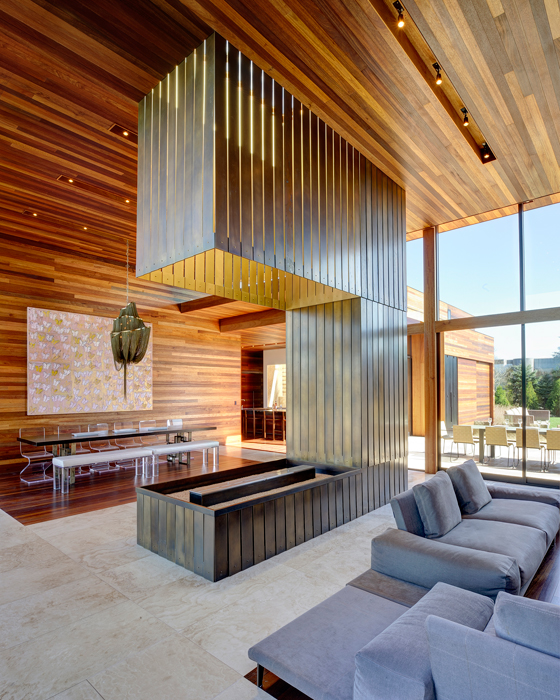
This arresting fireplace in a house in Bridgehampton, New York, is designed to be functional and sculptural: it comprises a load-bearing moment frame, while its bronze surface and bold volume evokes a sculpture; photo: Bates Masi + Architects
×Equally arresting is the gargantuan fireplace by Bates Masi Architects in a private house in Bridgehampton, New York, conceived as both a sculptural and structural feature. It comprises a (load-bearing) moment frame that allows the living room-cum-dining room in which it stands to be bigger. But it also has decorative, sculptural qualities: its exterior is clad in dark bronze, while the interior of the hood is lined with polished bronze rendered more luminous by a skylight above.
By contrast, sandellsandberg’s design encased in a concrete block in a house in the Swedish fishing village of Kivik is minimalist, boxy and austere. Simple perhaps, but it’s architecturally clever: the fireplace acts as a room divider, separating the dining and living areas, but keeps both spaces equally warm since it’s open on two sides.
Richard Lindvall’s interior for a restaurant in Stockholm uses copper for a fireplace hood, given that its rich hue evokes the warmth and colour of fire. Copper is also used for the tops of tables, radiators and exposed electrical pipes and plumbing
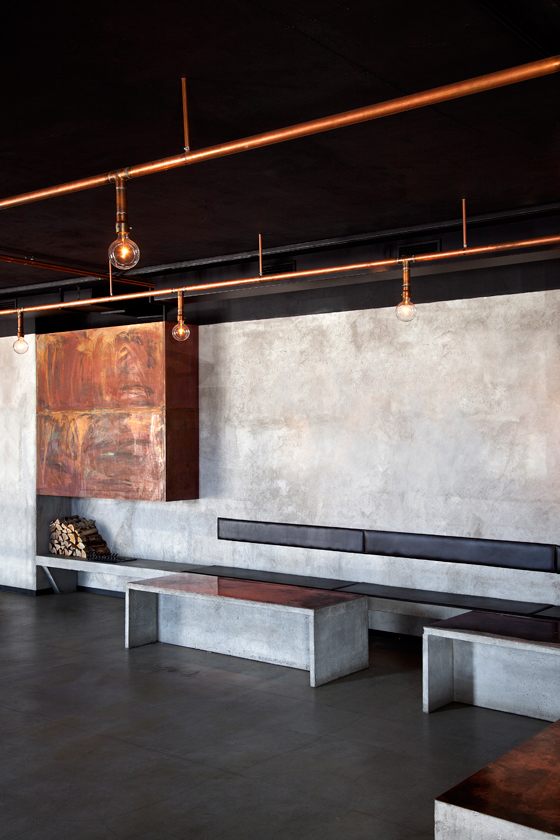
Richard Lindvall’s interior for a restaurant in Stockholm uses copper for a fireplace hood, given that its rich hue evokes the warmth and colour of fire. Copper is also used for the tops of tables, radiators and exposed electrical pipes and plumbing
×And Swedish designer Richard Lindvall has covered a fireplace at the Polish Nazdrowje restaurant and bar in Stockholm in copper, its fiery hue aptly evoking glowing embers. With its concrete walls and white tiles, the style of the venue (formerly a car park) is predominantly industrial and hard-edged – Lindvall visited factories in Poland for inspiration – and the warmly textured fireplace was chosen to offset this. ‘I wanted it to give the space warmth and to contrast with the concrete,’ he says.
Undeniably, with architects today reigniting our time-honoured fondness for fireplaces, we’re witnessing more than just a small flicker of interest in the age-old hearth.


